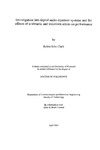Investigation into digital audio equaliser systems and the effects of arithmetic and transform errors on performance
| dc.contributor.author | Clark, Robin John | |
| dc.contributor.other | Faculty of Science and Engineering | en_US |
| dc.date.accessioned | 2011-09-22T12:04:56Z | |
| dc.date.available | 2011-09-22T12:04:56Z | |
| dc.date.issued | 2001 | |
| dc.identifier | Not available | en_US |
| dc.identifier.uri | http://hdl.handle.net/10026.1/595 | |
| dc.description | Merged with duplicate record 10026.1/2685 on 07.20.2017 by CS (TIS) | |
| dc.description.abstract |
Discrete-time audio equalisers introduce a variety of undesirable artefacts into audio mixing systems, namely, distortions caused by finite wordlength constraints, frequency response distortion due to coefficient calculation and signal disturbances that arise from real-time coefficient update. An understanding of these artefacts is important in the design of computationally affordable, good quality equalisers. A detailed investigation into these artefacts using various forms of arithmetic, filter frequency response, input excitation and sampling frequencies is described in this thesis. Novel coefficient calculation techniques, based on the matched z-transform (MZT) were developed to minimise filter response distortion and computation for on-line implementation. It was found that MZT-based filter responses can approximate more closely to s-plane filters, than BZTbased filters, with an affordable increase in computation load. Frequency response distortions and prewarping/correction schemes at higher sampling frequencies (96 and 192 kHz) were also assessed. An environment for emulating fractional quantisation in fixed and floating point arithmetic was developed. Various key filter topologies were emulated in fixed and floating point arithmetic using various input stimuli and frequency responses. The work provides detailed objective information and an understanding of the behaviour of key topologies in fixed and floating point arithmetic and the effects of input excitation and sampling frequency. Signal disturbance behaviour in key filter topologies during coefficient update was investigated through the implementation of various coefficient update scenarios. Input stimuli and specific frequency response changes that produce worst-case disturbances were identified, providing an analytical understanding of disturbance behaviour in various topologies. Existing parameter and coefficient interpolation algorithms were implemented and assessed under fihite wordlength arithmetic. The disturbance behaviour of various topologies at higher sampling frequencies was examined. The work contributes to the understanding of artefacts in audio equaliser implementation. The study of artefacts at the sampling frequencies of 48,96 and 192 kHz has implications in the assessment of equaliser performance at higher sampling frequencies. | en_US |
| dc.description.sponsorship | Allen & Heath Limited | en_US |
| dc.language.iso | en | en_US |
| dc.publisher | University of Plymouth | en_US |
| dc.title | Investigation into digital audio equaliser systems and the effects of arithmetic and transform errors on performance | en_US |
| dc.type | Thesis | en_US |
| dc.identifier.doi | http://dx.doi.org/10.24382/1373 |
Files in this item
This item appears in the following Collection(s)
-
01 Research Theses Main Collection
Research Theses Main


